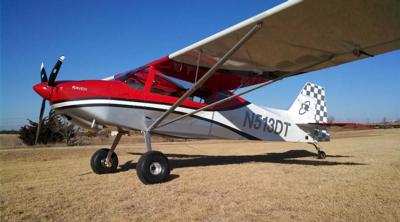Tue, Aug 12, 2014
Fabric Covered Airplanes Are Not Making A Comeback Because They Never Left The Scene
In the realm of recreational aviation, it is common to see lightweight airplanes with fabric covering. At first glance, it’s easy to believe that a fabric covered airplane is an old technology that simply didn’t go away. Nothing could be further from the truth.

In the history of powered aircraft a fabric covering of some sort was usually involved in almost all earlier airplanes. While it is commonly heard from people outside of aviation that these were “canvas covered airplanes,” the fact is that canvas is far too heavy to be used to cover an airplane.
The most common fabrics used in aircraft covering up until the early 1960s were either cotton or linen. While these fabrics served the purpose they did have some drawbacks because they were organic in origin. Different temperatures, moisture content in the air, and whether or not the plane was parked in a hangar or outside, had a lot to do with how long they would last. In the harshest conditions the cotton and linen fabrics could become unusable in as little as four or five years.
Starting in the late 1950s new synthetic fabrics came into use. The ability to use these new fabrics in creative ways resulted in fabric covered airplanes becoming a modern extension of a well-known technology. There are numerous processes available for the use of the synthetic materials and these processes must be FAA approved if they are used on type certificated aircraft. Special light sport and amateur built aircraft have some really great choices of fabric process techniques. If these new fabrics are applied correctly, there usable lifetime can well exceed 20 or 30 years.
The bottom line is if you’re after a lightweight rugged aircraft, fabric has some real advantages. Airplanes constructed of aluminum or composite materials are designed in a way that the outside covering lends to the total structural strength of the aircraft. Another way to look at it is that with these types of aircraft, damage to the exterior composite or metal structure may jeopardize the strength of the entire structure. That’s not the case with a fabric covered airplane.
An airplane that is covered with a fabric material has an internal structure completely independent of the skin that surrounds it. Damaging the fabric does not affect the structural integrity of the aircraft part itself unless the damage that tore the fabric also damaged the structure. It was demonstrated on a television show that a fabric airplane with severe fabric damage could be repaired well enough with duct tape to become flyable.
Light, durable, and easily repaired, a fabric covered plane could be the perfect choice.
(Image: Fabric covered Rans S-20 from file)
More News
Also: B-29 Superfortress Reunion, FAA Wants Controllers, Spirit Airlines Pulls Back, Gogo Galileo Van's Aircraft posted a short video recapping the goings-on around their reorganiz>[...]
Light Gun A handheld directional light signaling device which emits a brilliant narrow beam of white, green, or red light as selected by the tower controller. The color and type of>[...]
"The journey to this achievement started nearly a decade ago when a freshly commissioned Gentry, driven by a fascination with new technologies and a desire to contribute significan>[...]
"Our driven and innovative team of military and civilian Airmen delivers combat power daily, ensuring our nation is ready today and tomorrow." Source: General Duke Richardson, AFMC>[...]
Aircraft Conflict Predicted conflict, within EDST of two aircraft, or between aircraft and airspace. A Red alert is used for conflicts when the predicted minimum separation is 5 na>[...]
 Airborne 04.16.24: RV Update, Affordable Flying Expo, Diamond Lil
Airborne 04.16.24: RV Update, Affordable Flying Expo, Diamond Lil ANN's Daily Aero-Term (04.20.24): Light Gun
ANN's Daily Aero-Term (04.20.24): Light Gun Aero-News: Quote of the Day (04.20.24)
Aero-News: Quote of the Day (04.20.24) Aero-News: Quote of the Day (04.21.24)
Aero-News: Quote of the Day (04.21.24) ANN's Daily Aero-Term (04.21.24): Aircraft Conflict
ANN's Daily Aero-Term (04.21.24): Aircraft Conflict



